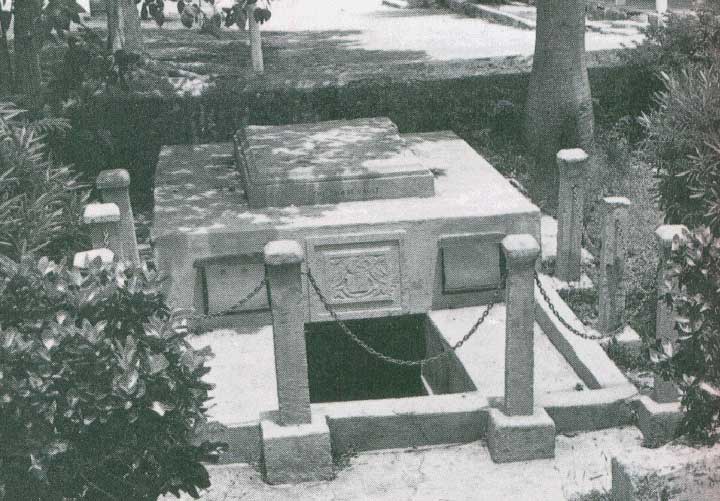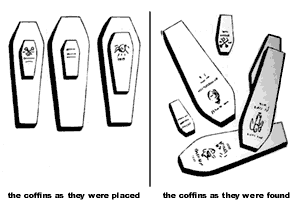| |
Unexplained Mysteries - The Moving Coffins of Barbados |
|
 |
|
There is a famous legend on the island of Barbados of coffins that are moved by unknown forces. Though the details surrounding the phenomenon are sketchy, the enigma is one that has fascinated researchers for over a century.
The events took place in the Chase Vault, located in a West Indian cemetery. The vault, situated about seven miles from Bridgetown, is a large structure built for the Chase family and their close friends. It was built roughly half above and half below the ground, which allowed for some degree of protection from the elements.
The vault was slowly filled with the dead members of the Chase family. The first placed inside the vault was Mrs. Thomasina Goddard, in a simple wooden coffin built in July, 1807. Two-year-old Mary Ann Chase was placed in the vault the very next year. The older sister of Mary Ann, Dorcas Chase, was put into the vault on July 6, 1812. Some claim that Dorcas starved herself after her father forced her into depression. Nonetheless, a few weeks later her father, Thomas Chase, was placed into the vault. Legend says that Thomas was one of the most hated men in Barbados.
| When the Chase Vault was open for the burial of Thomas the funeral party was stunned to find that none of the coffins were in the proper place. The group was angered- the theory being that grave robbers found a way into the grave and tossed the coffins about in search of loot. The entrance was a problem for robbers- a gigantic rock slab was cemented in place, covering the only entrance. Each time the vault was opened the cement had to chipped away and several men were needed to move the rock. Eventually it was decided that the gravediggers had some how disturbed the coffins.
|
 |
The coffins were replaced and the lead coffin of Thomas Chase was put in place. The vault was then resealed as it had been before.
On September 25, 1816 the vault was opened for the burial of eleven-year-old Charles Brewster Ames. Similar to the previous instance, each of the coffins was misplaced and thrown about- including the two hundred forty pound coffin of Thomas was thrown from its resting place! The vault was put back in order and resealed once again.
Fifty-two days later, Samuel Brewster was to be buried. This time a large group of witnesses crowded the scene looking for the mystery to continue. The slab of stone, which covered the door, was carefully examined. No defects were found, and the vault was opened. To no ones surprised the vault was once again in disorder. Mrs. Goddard's coffin, the only wooden one placed in the vault, was badly damaged. It was wrapped in wire to keep it together.
Several investigators, including the Reverend Thomas Oderson, examined the vault. Nothing could be found that would indicate a cause for the strange happenings, so the vault was once again cleaned and sealed.
On July 17, 1819 the vault was once again opened and once again the vault was found to be in disorder. The only coffin untouched was the wooden and fragile one of Mrs. Goddard's. This time, the governor of the island, Lord Combermere, ordered his own professional investigation. The entire vault was looked over, and nothing strange could be found. The coffins were restacked and sand was placed on the floor to catch the footprints of the perpetrators. Mrs. Goddard's wooden coffin was stacked against a wall since it was so frail. The vault was then resealed and personal seals of the governor were placed on concrete. Everyone of the island waited for the next reopening.
The next opening of the vault was not for a burial but for the Governor's curiosity. On April 18, 1820, the Governor and several friends traveled to the vault and found his seal unbroken. When the vault was opened, however, it was found that the coffins were in disarray - some were even flipped upside down! The sand revealed no footprints.
The coffins were promptly removed from the vault and buried elsewhere on the island. Upon inspection, the vault was found to contain no water, and no way for water to enter it. Earthquakes were also eliminated- why would the quakes only affect one section of the chamber and leave the wooden coffin alone?
Some have speculated that the entire event never took place. Records show, however, that the Chase vault has and did exist. The vault is and has been for sometime? empty.
A Masonic hoax?
These four spottily documented nineteenth century incidents have no twentieth-century equivalents, but they have attracted the attentions of such thoughtful latter-day writers as Lang, Rupert T. Gould, and Joe Nickell, who are responsible for the most thorough modern examinations.
Of these only Nickell comes to a firm conclusion. He argues that none of these incidents ever happened in the real world. The only one for which much information is available, the Barbados episode, is loaded with symbols and phrases which Freemasons would recognize. Nickell, who had investigated an earlier Masonic hoax involving a tale of buried treasure, contends the Barbados story was fashioned around the Masonic allegory of a "secret vault" which, according to a Masonic text, "was ... in the ancient mysteries, symbolic of death, where alone Divine Truth is to be found .... We significantly speak of the place of initiation as 'the secret vault, where reign silence, secrecy and clarkness.' It is in this sense of an entrance through the grave into eternal life, that the Select Master is to view the recondite but beautiful symbolism of the secret vault. Like every other myth and allegory of Masonry, the historical relation may be true or it may be false; it may be founded on fact or the invention of imagination; the lesson is still there, and the symbolism teaches it exclusive of the history."
Along with other suggestive evidence Nickell quotes these words from Lucas: "I examined the walls, the arch and every part of the vault and found every part old and similar; and a mason in my presence struck every part of the bottom with his hammer and all was solid." Nickell remarks, "In the Royal Arch degree of Masonry-to which the 'arch' above may have been in cryptic reference (just as the 'vault' suggests the 'secret vault' which, in Masonry, is said to have been 'curiously arched' ) -there is a reference to the 'sound of a hammer'. According to Macoy's Illustrated History and Encyclopedia of Freemasonry, 'The blow of the Master's hammer commands industry, silence, or the close of labour, and every brother respects or honors its sound."' He goes on to quote from the Royal Arch decree ("We have examined the secret vault") and notes that the striking of stone-to determine its solidness -"is the means by which the secret vault is sought for and finally located!" Of course Lucas's use of the word "mason" here is also interesting.
Through his investigation Nickell learned that the men who supposedly participated in the events were Freemasons-as was Robert Dale Owen, chronicler of the alleged episode at Oesel. He also speculates that prominent Freemasons knew of the hoax. One was Sir Arthur Conan Doyle who, discussing the Barbados coffins in a December 1919 article in The Strand, used a word ("effluvia") whose significance only Masons would recognize. The word is "well known to Masons since it appears in the Master Mason degree," according to Nickell; "not only that, but it does so specifically in reference to 'the grave!...
Though based entirely on circumstantial evidence, Nickell's speculations are intriguing and well argued. They are also, at this late date, unprovable. In any case, there is no compelling reason to believe any of the moving-coffin stories describe real-life occurrences.

Discuss article |
Article Link
|
More unsolved mysteries on Unexplained Mysteries
|



![]()